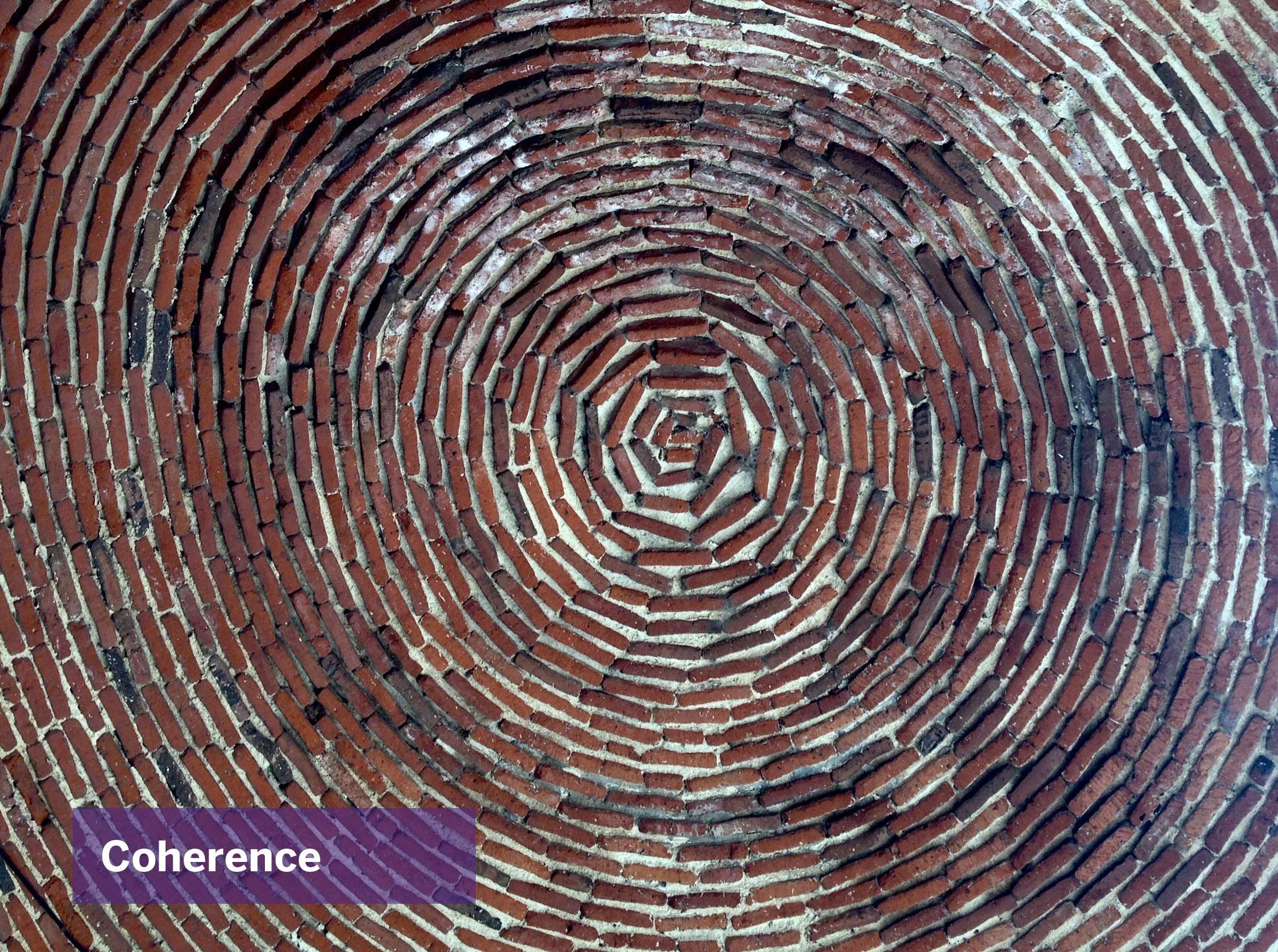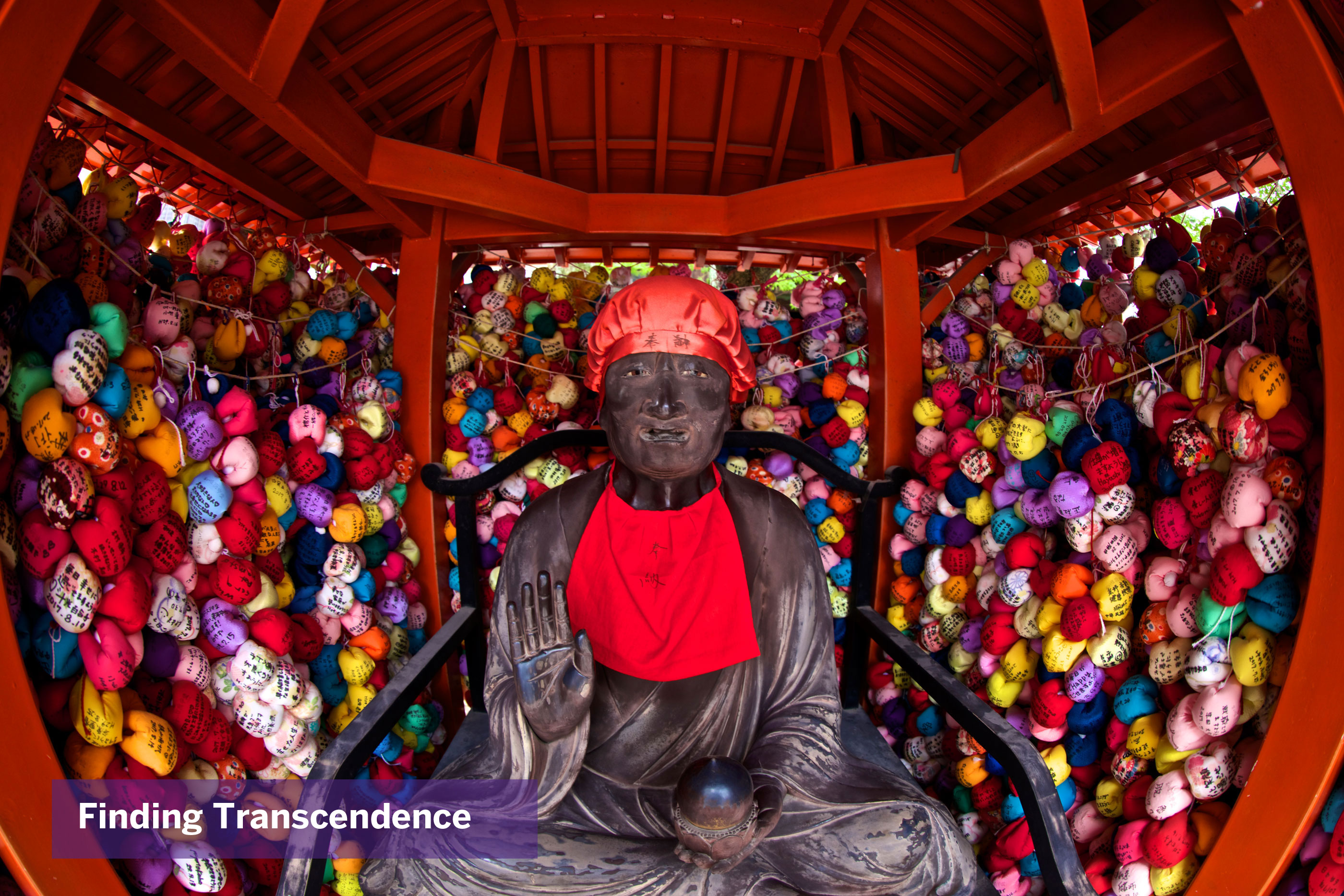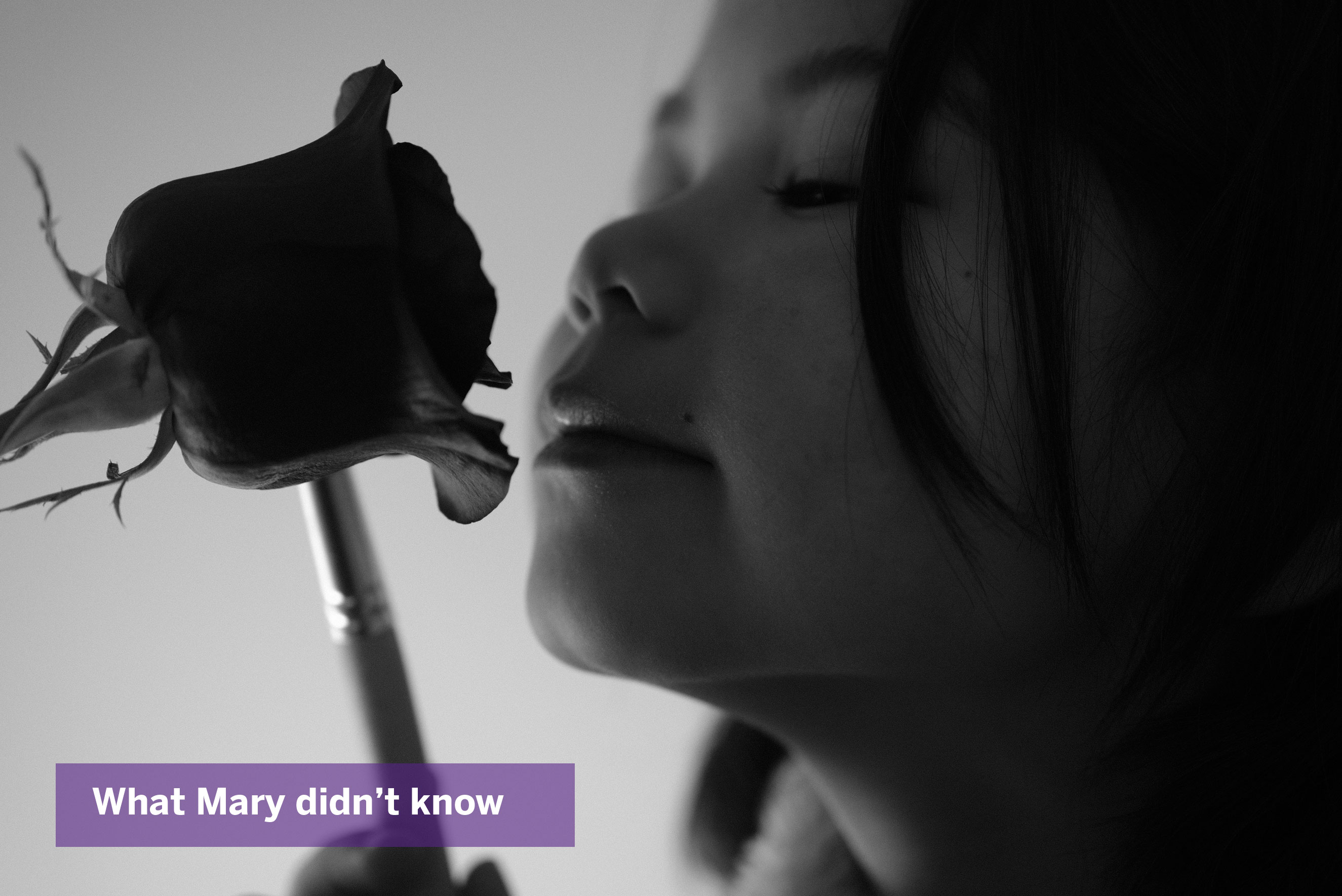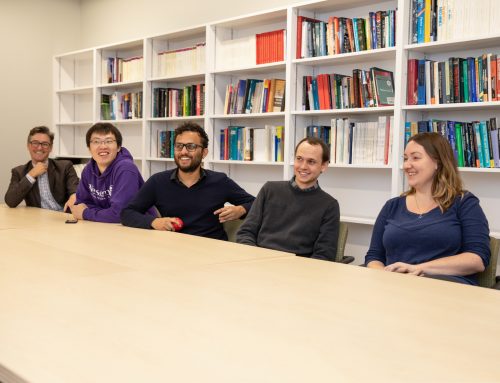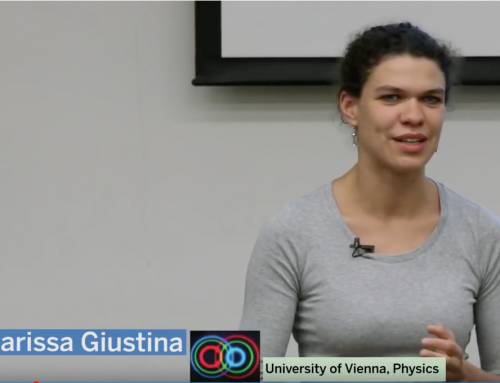
After launching a very successful photo contest last year, the Rotman Institute was honoured (and excited!) to hold our 2nd Annual Philosophical Photography Contest. As before, people were invited to submit photos that managed to capture an abstract philosophical concept in a creative way. This year we received submissions that tackled a range of issues in philosophy, and our panel of judges had an extremely difficult time in selecting their favourites. Photos were judged on both how well they conveyed a philosophical concept, and on technical execution (composition, colour, focus, etc.).
The winning photo, titled ‘Qualia’ and submitted by Mark Bessoudo, is shown above. Our judges felt this image was not only visually arresting, with its bold colours and stark contrasts, but it also did a fantastic job of depicting the concept of quaila. Mark included the following description along with this entry:
Consider your visual experience as you look at a royal blue wall. There is something it is like for you subjectively to undergo that experience, some phenomenological character that this experience has. There is a “blueness” to the royal blue. This experience is very different from what it is like to experience the “redness” of a ruby red window shutter. This ineffable, intrinsic, private, non-physical subjective experience is called “qualia”. While there is still debate about how qualia relate to the physical world both inside and outside our minds, the concept remains central to a proper understanding of the nature of consciousness.
Please join us in congratulating Mark on being the winner of this year’s photo contest!
In addition to ‘Qualia’, we received a number of other thought-provoking images that were given honourable mentions. All are included in the photo gallery below. Note that clicking on any of the images included in the gallery below will open up a full page slide show. Names and descriptions for each photo are listed beneath the gallery.
‘Coherence’, submitted by Erlantz Etxeberria
Philosophers have used the notion of coherence to make sense of elusive concepts such as truth and justification. For instance, coherentist philosophers argue that a sentence is true if it coheres or fits with a certain set of sentences. In epistemology, coherentist theories hold that a belief is justified if it coheres or fits with a set of beliefs. In this picture, every brick fits a position in the web that the rest of bricks form, in the same way that a belief fits in the web formed by other beliefs. Every brick seems to cohere with the set of bricks. The picture is a close up of the ceiling at the entrance of the Etchmiadzin Cathedral, in Armenia. It is considered the oldest cathedral in the world, built around the year 300, and it is a holy place for the Armenian Catholic Church.
‘Falsification: better 1 black swan, than 10 black ravens’, submitted by Sylvia Wenmackers
The observation of a single black swan suffices to falsify the universal hypothesis (once believed by Europeans) that all swans are white. Yet, no number of observed black ravens suffices to verify the universal hypothesis that all ravens are black. Because of this asymmetry between falsification and verification, philosopher of science Karl Popper stressed the importance of falsifiability of scientific statements.
‘Finding transcendence’, submitted by Pablo Andres López Silva
Is human life a mere by-product of pure physical randomness? does human existence have a trascendental meaning? does human life end when the physical body dies? can we really experience transcendence? is there any connection between nature and the soul? is that connection what we called God?
‘What Mary didn’t know’, submitted by Jonathan Faerber
Both philosophy and photography are exercises in identifying, understanding and negotiating the boundaries of our fundamentally human understanding and perspectives. For example, although monochrome images contain plenty of information about the physical properties of light and objects in the shades of a single hue, this limited physical record excludes qualitative features of a multi-dimensional, multi-sensory human experiences of, say, seeing a rose as red or smelling it as fragrant. As Frank Jackson put it, “nothing you could tell of a physical sort captures the smell of a rose”–the methods of philosophy and photography necessarily fall short of a complete objective account “about the hurtfulness of pains, the itchiness of itches, pangs of jealousy, or about the characteristic experience of tasting a lemon, smelling a rose, hearing a loud noise or seeing the sky” (from Jackson’s “Epiphenomenal Qualia”, 127) .
‘Faces in the Moon (1 – 4)’, submitted by Daniel Jayes O’Brien
In his Natural History of Religion (1757) David Hume notes the ‘universal tendency among mankind to conceive all beings like themselves, and to transfer to every object, those qualities, with which they are familiarly acquainted, and of which they are intimately conscious. We find human faces in the moon, armies in the clouds; and by a natural propensity, if not corrected by experience and reflection, ascribe malice or good-will to every thing, that hurts or pleases us’ (141). For Hume such anthropomorphism grounds a genealogy of religious belief: belief in God is explained by this feature of human nature, and not by natural theology or revealed religion. Contemporary cognitive science of religion investigates the mechanisms that account for this tendency. In his Religion Explained (2001) Pascal Boyer argues that we have hyperactive agent detection devices that incline us to see faces in the moon, for example, and, following Hume, provide an explanation for widespread belief in gods. Such devices were responsible for these ‘faces’ catching my eye.
‘The A-theory and the B-theory of time’, submitted by Jiri Benovsky
The passage of time is one of the key notions in the debate about the metaphysics of time. A-theorists hold that time genuinely passes, or flows, and that reality is fundamentally tensed. B-theorists maintain that passage of time is merely a perceptual phenomenon and that metaphysically speaking time does not pass, it is ‘static’. B-theory is often coupled with eternalism – the view that all times (past, present, and future) exist. A-theory is often coupled with the view that only one time, the present, exists. Depending on how one looks at this picture, one might see it as an illustration of A-theory or of B-theory. Indeed, this photograph shows change, movement, and the passage of time, but it also shows an extended period of time where a multitude of instants ‘exists’.
‘Cognitive closure’, submitted by Mark Bessoudo
“If the human brain were so simple that we could understand it, we would be so simple that we couldn’t.” — Emerson M. Pugh, The Biological Origin of Human Values What if the human mind is intrinsically incapable of solving certain philosophical problems, such as those related to free will, the mind-body problem, consciousness, and even epistemology itself? The concept known as “cognitive closure” argues that answers to certain philosophical questions will be forever beyond our grasp. Adherents of the cognitive closure argument explain that, owing to facts about the biological structure and operation of our minds, humans are “locked in” to a specific range of potential knowledge. There are some things we can come to know, while others we cannot. This does, however, leave the door open for the possibility that these questions could, at least in principle, be answered by another non-human intelligence.
‘Memory’s images’, submitted by John Jacobs
“Memory’s images, once they are fixed in words, are erased,” Polo said. “Perhaps I am afraid of losing Venice all at once, if I speak of it, or perhaps, speaking of other cities, I have already lost it, little by little.” ― Italo Calvino, Invisible Cities Reflection of buildings flanking the docks of Copenhagen, Denmark. The memories of cities, people, places, and events often blur with time. Photo taken with intentional distortion to deliberately allow the mind to ‘fix’ the memory as it would naturally, whether the memory is accurate or not.
‘Vibrance of you’, submitted by Yousuf Hasan
I took this shot on a boat at Lac des Sables, approximately 100 kilometers north of Montreal in a town called Sainte-Agathe-des-Monts. “Vibrance of You” makes me think about the nature of perception. Do the things we care about infuse our perception of reality? Some philosophers argue that our experiences of things are mainly shaped by aspects of our minds. Others suggest that our perceptual experience is more direct in that the objects of our experiences reflect features of the world external to us. Is there such a thing as a pure view of the world or are we always imposing our desires or past-experiences on reality? In “Vibrance of You,” what do you see? “To see a landscape as it is when I am not there. When I am in any place, I disturb the silence of heaven and earth by my breathing and the beating of my heart.”—Simone Weil
‘Lost in the sound of translation’, submitted by Pablo Andres López Silva
Imagine yourself in a trip to Asia suddenly running into a previously unknown group of people. You realize the speak a very rare language you are not able to understanding and not prior translations are available. How to communicate with them? Is there any way we can be sure about the meaning or reference that a speaker of that rare language attaches to an utterance coming from his mouth? If any, what’s the relationship between these utterances and the speaker’s behavior? can we really express what we are thinking in a different language? Are we lost in the sound of translation?
‘Derek Parfit on personal identity’, submitted by Jiri Benovsky
Derek Parfit was one of the most influential philosophers when it comes to the debate about personal identity. He famously insisted on fictional cases of ‘fission’ where an individual is ‘split’ into two or more individuals, thus providing a series of thought-experiments where our concepts of identity of persons through time can be usefully tested. The question is: after a fission occurred, which one of the resulting persons is the original person?
Thank you to everyone who participated in our philosophical photography contest this year! The photos submitted prompted wonderful discussions among our judges & we look forward to another round of entries next year!

